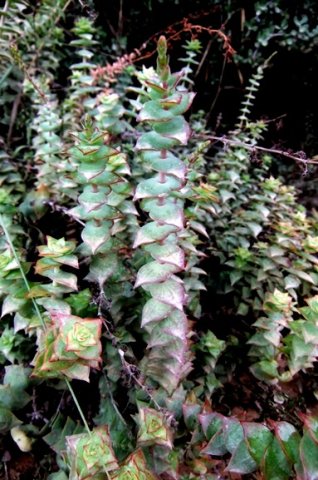Crassula perforata

Crassula perforata is a sprawling and rambling shrublet growing to 60 cm in height.
The name perforata originated from the Latin word, perforare, meaning to pierce, to bore through or to make a hole through. This refers to the fusion of the opposite leaves in a back-to-back, joined pair. The pair forms one structure with a hole in the centre once the leaves are loosened from the stem.
This has prompted local children to make toy necklaces, loosening the leaf-pairs as beads, or just playing with the loosened leaves still on the stem as makeshift whirligigs. The Afrikaans colloquial name of inrygertjie (little stringer) refers to this feature. The names necklace vine and concertina crassula are also on record.
The stems in picture are starting inflorescences from their tips at the end of August. Unaided by shrub support, the stems manage an erect stance that may be lost later as mass is added and aid from surrounding plants not forthcoming. Sometimes exceeding 1 m in length, the stems seldom branch apart from at the base.
The species distribution is from Riviersonderend in the Western Cape through the Eastern Cape to KwaZulu-Natal.
The plants are often seen in rocky scrub veld and on dry cliff faces. They are adapted to various soil types in several ecological settings including succulent Karoo, fynbos, Nama Karoo and here in Albany thicket. Neither of the two subspecies of C. perforata is considered to be threatened in its habitat early in the twenty first century (Smith and Crouch, 2009; Van Jaarsveld, et al, 2006; Gledhill, 1981; www.smgrowers.com; http://redlist.sanbi.org).

